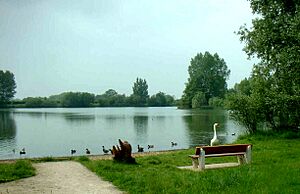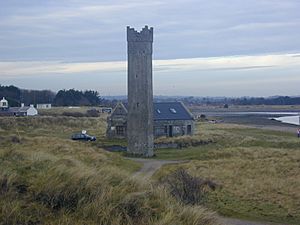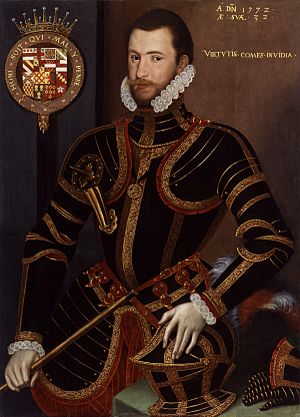Henry Draycott facts for kids
Henry Draycott (born around 1510, died 1572) was an important English official and judge in Ireland during the 1500s. He held many big jobs for the King and Queen, including being in charge of Ireland's money department, known as the Chancellor of the Exchequer of Ireland. Even though it's not clear if he had formal legal training, he became a very successful judge. He served as a high-ranking judge in the Court of Exchequer (Ireland) and as Master of the Rolls in Ireland. He also became a wealthy landowner in a special area of Ireland called the Pale, with his main home at Mornington, County Meath.
His daughter Alice died in 1576 under unclear circumstances after a big dinner at Dublin Castle. The Earl of Essex, a powerful leader in Ireland, also died around the same time. Some people thought they were poisoned, but it's much more likely they both died from a natural illness.
Contents
Who Was Henry Draycott?
Early Life and Career
Henry Draycott came from Denby in Derbyshire, England. His family name probably came from the nearby village of Draycott, Derbyshire. We don't know much about his parents or his early life. Even though he became a famous judge, it's not clear when he became a lawyer, or if he was a trained lawyer at all.
He first appeared in Ireland in 1544. His first official job was as the money manager for Wexford. He also received land from the Crown in Wexford.
Working for the Government
Important Roles and Missions
Draycott quickly became a very important person in the Irish government. He was appointed Chief Remembrancer, a senior role in the Court of Exchequer. His job was to get all the important papers ready for the judges to read.
In 1560, he was chosen to be one of the two members for Naas in the Irish Parliament. He was sent on several important political trips to England. He was also a strong supporter of Sir Henry Sidney, who was the Lord Deputy of Ireland (the Queen's main representative). Draycott was given the task of settling a disagreement between two powerful Irish leaders, the Earl of Ormond and the Earl of Desmond. He also helped with the settlement of Munster in 1567.
Acquiring Land in Ireland
Draycott was given many properties in County Meath and County Louth. His main estate was at Mornington in Meath. He also owned land near Drogheda called Donnycarney, and other property in Dundalk. Like most English settlers in Ireland, he didn't pay much attention to the rights of the people who originally owned the land. He was willing to help other settlers get land, sometimes by creating false documents to prove ownership. For example, the historian John Hooker mentioned that Draycott helped Sir Peter Carew get his large Irish estates.
Henry Draycott's Judicial Work
Becoming a Judge
Draycott was appointed a Baron of the Court of Exchequer (Ireland) in 1563. Then, in 1566, he became the Master of the Rolls. Even though he was known for being honest, some people wondered if he was right for these jobs because it wasn't clear if he had any legal training.
However, the Master of the Rolls job back then was more about managing records than judging cases. Draycott was very good at organizing things. One of his main tasks was to look through, sort, and organize official government papers. The Barons of the Exchequer were originally tax collectors, not judges. While they later became professional lawyers, collecting money for the government was still a very important part of their job.
Challenges and Health Issues
Another concern about his appointment to high office was his ongoing poor health. In 1567, his friend Sir Henry Sidney, the Lord Deputy of Ireland, said Draycott was "a very sick and a weak man." Surprisingly, when the next Baron, Richard Edwarde, retired in 1570, Draycott returned to his old job at the Exchequer, even though he was getting weaker. He was also chosen as one of the managers of the King's Inn, a place for lawyers, in the same year. He died in 1572.
What Was He Like?
His Reputation
Even without clear legal training, Draycott was praised as an honest judge. People also said he served the Crown very well. However, he was also known for wanting to get a lot of land, sometimes using unfair methods. He was willing to help other settlers, like the greedy Sir Peter Carew, get land through similar tricky deals.
Unlike most English settlers at the time, he might have had some sympathy for Roman Catholics. Even though all public officials after 1560 had to appear Protestant, his family became openly Roman Catholic just a few years after he died.
Queen Elizabeth I's Opinion
Queen Elizabeth I thought highly of Draycott. When he died, she wrote that she was sad to lose someone she thought was a good and loyal servant. She hoped he had gone to a better place.
His Family and Descendants
His Children and Grandchildren
Draycott was married to Mary and had at least three children: John, Alice, and another daughter whose name we don't know. This second daughter married Christopher Plunkett, a younger son of the Baron of Dunsany.
After Henry's death, his widow, Mary, married Owen Moore. In 1577, Owen was given the right to look after his stepson John and arrange his marriage. John later became Sir John Draycott. He married Anne Barnewall and they had six children.
The Mystery of Alice Draycott's Death
Henry's daughter Alice died under unclear circumstances after getting sick at a big dinner at Dublin Castle in September 1576. The Earl of Essex, a powerful leader, also died around the same time. Some people spread rumors that they had been poisoned by the Earl of Leicester, who was Essex's rival. However, a medical examination of Essex found no proof of poisoning. It is most likely that both Essex and Alice died from an illness called dysentery, which causes severe diarrhea. Several other guests at the dinner also got very sick, but none of them claimed to have been poisoned. Leicester's enemies often blamed him for sudden deaths of people he had argued with, but there seems to be no truth to any of these claims.
Later Generations and a Famous Lawsuit
Henry Draycott's last direct male descendant, Henry Draycott of Mornington, died in 1694 without any legal children. This led to a famous lawsuit called Draycott v. Talbot. In this case, a man named Edward Draycott claimed he was the younger Henry's legal son and heir, but he lost the case. The court made an important ruling: just because two names are listed as husband and wife in a church record doesn't automatically prove they were married. Other proof, like living together as a couple, must also be shown to prove the marriage happened.




